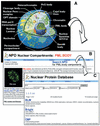The Nuclear Protein Database (NPD): sub-nuclear localisation and functional annotation of the nuclear proteome
- PMID: 12520015
- PMCID: PMC165465
- DOI: 10.1093/nar/gkg018
The Nuclear Protein Database (NPD): sub-nuclear localisation and functional annotation of the nuclear proteome
Abstract
The Nuclear Protein Database (NPD) is a curated database that contains information on more than 1300 vertebrate proteins that are thought, or are known, to localise to the cell nucleus. Each entry is annotated with information on predicted protein size and isoelectric point, as well as any repeats, motifs or domains within the protein sequence. In addition, information on the sub-nuclear localisation of each protein is provided and the biological and molecular functions are described using Gene Ontology (GO) terms. The database is searchable by keyword, protein name, sub-nuclear compartment and protein domain/motif. Links to other databases are provided (e.g. Entrez, SWISS-PROT, OMIM, PubMed, PubMed Central). Thus, NPD provides a gateway through which the nuclear proteome may be explored. The database can be accessed at http://npd.hgu.mrc.ac.uk and is updated monthly.
Figures


References
-
- Sutherland H.G.E., Mumford,G.K., Newton,K., Ford,L.V., Farrall,R., Dellaire,G., Cáceres,J.F. and Bickmore,W.A. (2001) Large-scale identification of mammalian proteins localized to nuclear sub-compartments. Hum. Mol. Genet., 10, 1995–2011. - PubMed

